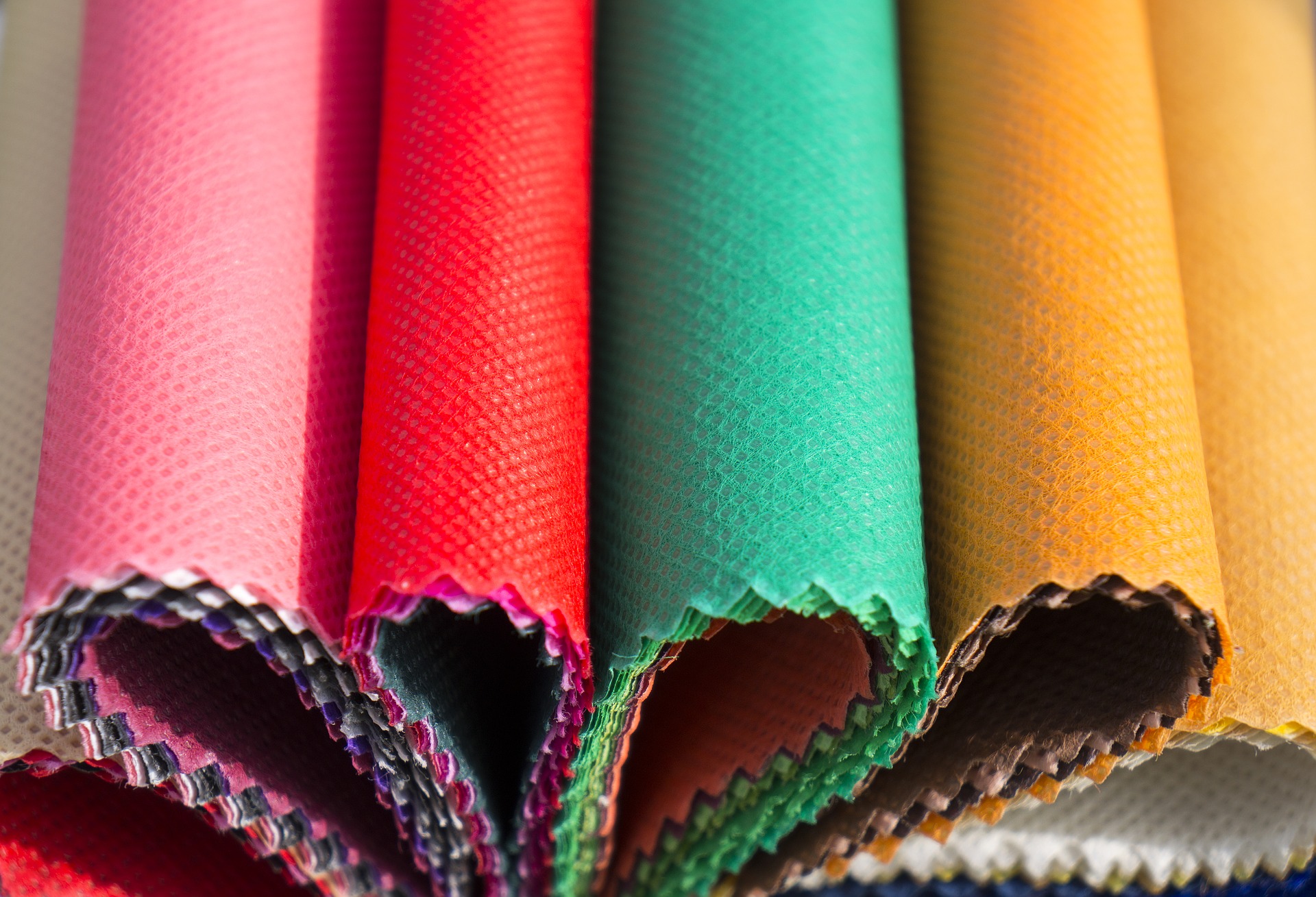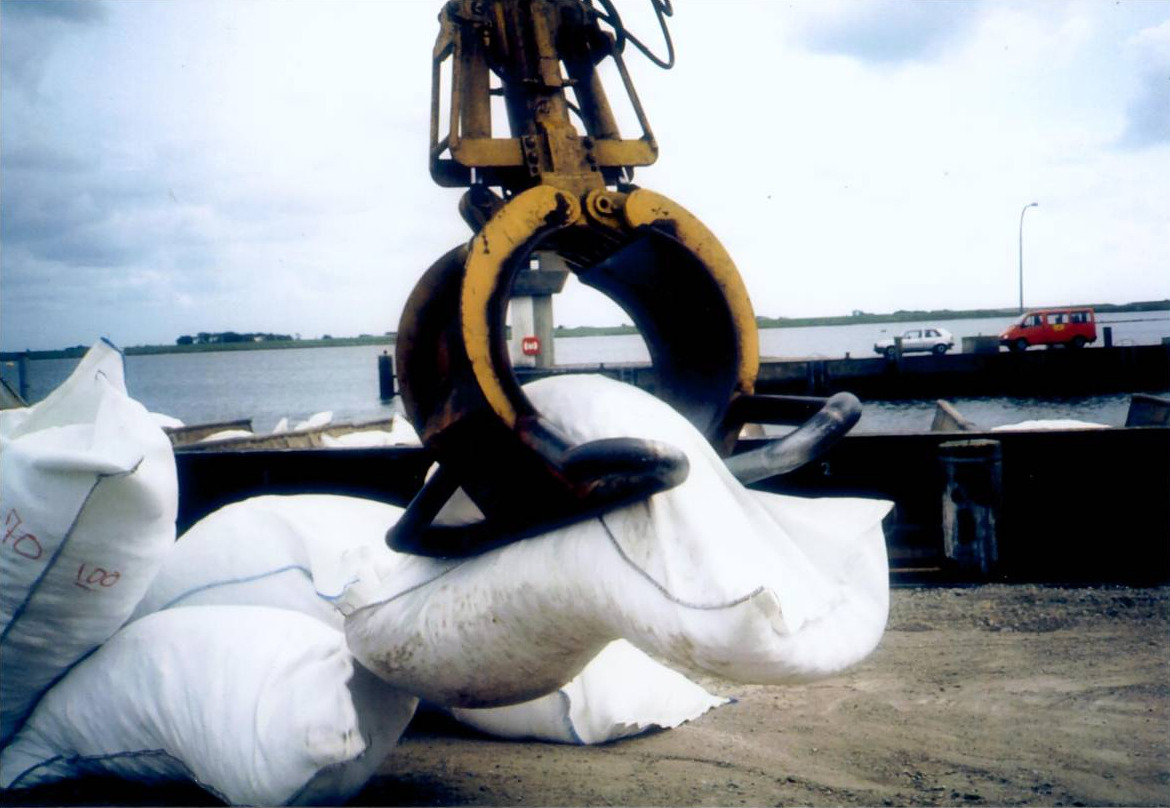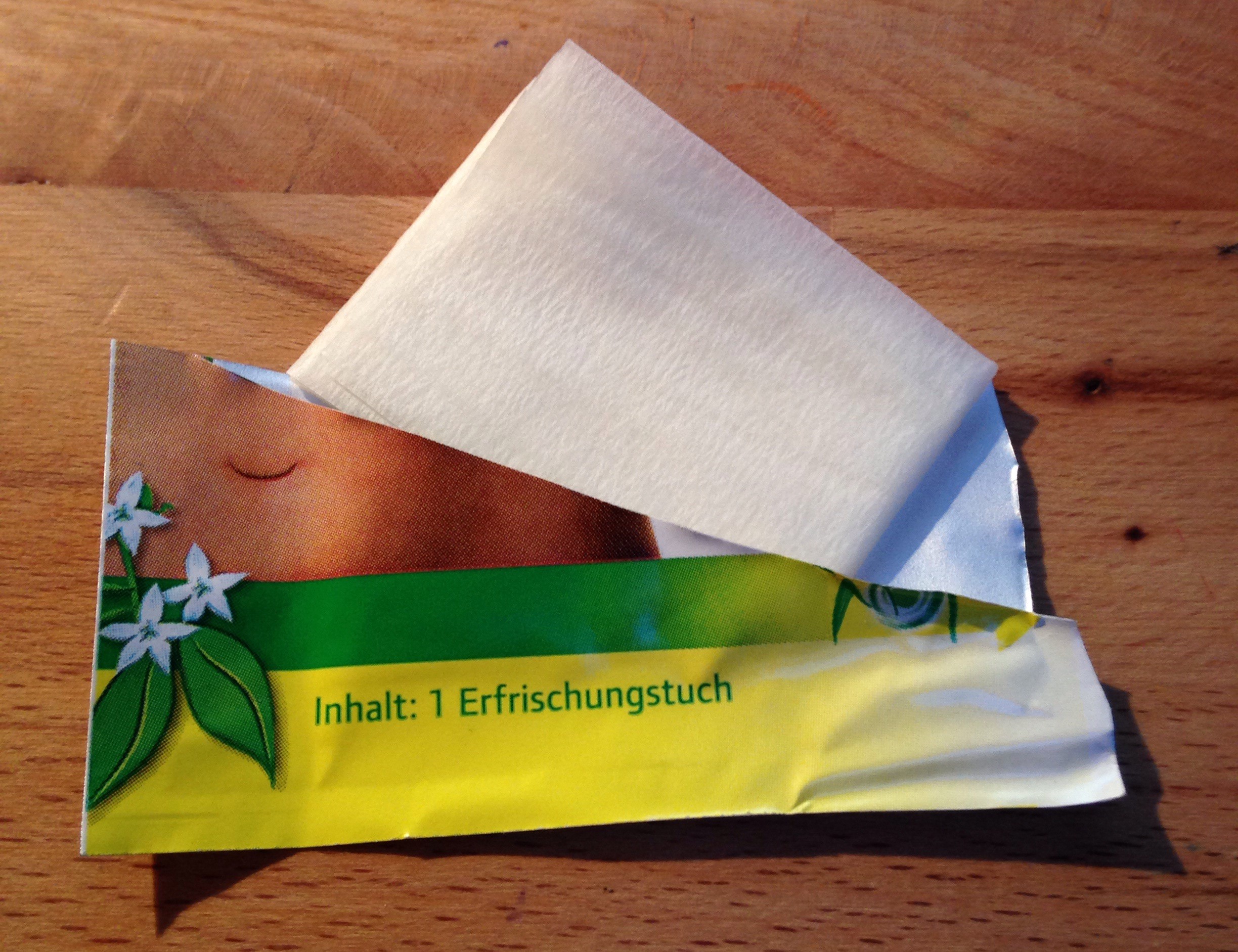|
Hydroentanglement
Hydroentanglement is a bonding process for wet or dry fibrous webs made by either carding, airlaying or wet-laying, the resulting bonded fabric being a nonwoven. It uses fine, high pressure jets of water which penetrate the web, hit the conveyor belt (or "wire" as in papermaking conveyor) and bounce back causing the fibres to entangle. Hydroentanglement is sometimes known as spunlacing, this term arising because the early nonwovens were entangled on conveyors with a patterned weave which gave the nonwovens a lacy appearance. It can also be regarded as a two-dimensional equivalent of spinning (textiles), spinning fibres into yarns prior to weaving. The water pressure has a direct bearing on the Units of textile measurement, gsm, and strength of the web, and very high pressures not only entangle but can also split fibres into micro- and nano-fibres which give the resulting hydroentangled nonwoven a leatherlike or even silky texture. This type of nonwoven can be as strong and tough as ... [...More Info...] [...Related Items...] OR: [Wikipedia] [Google] [Baidu] |
Nonwoven Fabric
Nonwoven fabric is a fabric-like material made from staple fibre (short) and long fibres (continuous long), bonded together by chemical, mechanical, heat or solvent treatment. The term is used in the textile manufacturing industry to denote fabrics, such as felt, which are neither woven nor knitted. Some non-woven materials lack sufficient strength unless densified or reinforced by a backing. In recent years, non-wovens have become an alternative to polyurethane foam. Applications Nonwoven fabrics are broadly defined as sheet or web structures bonded together by entangling fiber or filaments (and by perforating films) mechanically, thermally or chemically. They are flat or tufted porous sheets that are made directly from separate fibres, molten plastic or plastic film. They are not made by weaving or knitting and do not require converting the fibres to yarn. Typically, a certain percentage of recycled fabrics and oil-based materials are used in nonwoven fabrics. The percentage o ... [...More Info...] [...Related Items...] OR: [Wikipedia] [Google] [Baidu] |
Nonwoven
Nonwoven fabric is a fabric-like material made from staple fibre (short) and long fibres (continuous long), bonded together by chemical, mechanical, heat or solvent treatment. The term is used in the textile manufacturing industry to denote fabrics, such as felt, which are neither woven nor knitted. Some non-woven materials lack sufficient strength unless densified or reinforced by a backing. In recent years, non-wovens have become an alternative to polyurethane foam. Applications Nonwoven fabrics are broadly defined as sheet or web structures bonded together by entangling fiber or filaments (and by perforating films) mechanically, thermally or chemically. They are flat or tufted porous sheets that are made directly from separate fibres, molten plastic or plastic film. They are not made by weaving or knitting and do not require converting the fibres to yarn. Typically, a certain percentage of recycled fabrics and oil-based materials are used in nonwoven fabrics. The percentage o ... [...More Info...] [...Related Items...] OR: [Wikipedia] [Google] [Baidu] |
Carding
Carding is a mechanical process that disentangles, cleans and intermixes fibres to produce a continuous web or sliver (textiles), sliver suitable for subsequent processing. This is achieved by passing the fibres between differentially moving surfaces covered with "card clothing", a firm flexible material embedded with metal pins. It breaks up locks and unorganised clumps of fibre and then aligns the individual fibres to be parallel with each other. In preparing wool fibre for spinning, carding is the step that comes after teasing. The word is derived from the Latin meaning thistle or Dipsacus, teasel, as dried vegetable teasels were first used to comb the raw wool before technological advances led to the use of machines. Overview These ordered fibres can then be passed on to other processes that are specific to the desired end use of the fibre: Cotton mill, Cotton, Batting (material), batting, felt, woollen or worsted yarn, etc. Carding can also be used to create blends of dif ... [...More Info...] [...Related Items...] OR: [Wikipedia] [Google] [Baidu] |
Textiles
Textile is an umbrella term that includes various fiber-based materials, including fibers, yarns, filaments, threads, different fabric types, etc. At first, the word "textiles" only referred to woven fabrics. However, weaving is not the only manufacturing method, and many other methods were later developed to form textile structures based on their intended use. Knitting and non-woven are other popular types of fabric manufacturing. In the contemporary world, textiles satisfy the material needs for versatile applications, from simple daily clothing to bulletproof jackets, spacesuits, and doctor's gowns. Textiles are divided into two groups: Domestic purposes onsumer textilesand technical textiles. In consumer textiles, aesthetics and comfort are the most important factors, but in technical textiles, functional properties are the priority. Geotextiles, industrial textiles, medical textiles, and many other areas are examples of technical textiles, whereas clothing and ... [...More Info...] [...Related Items...] OR: [Wikipedia] [Google] [Baidu] |
University Of Tennessee
The University of Tennessee (officially The University of Tennessee, Knoxville; or UT Knoxville; UTK; or UT) is a public land-grant research university in Knoxville, Tennessee. Founded in 1794, two years before Tennessee became the 16th state, it is the flagship campus of the University of Tennessee system, with ten undergraduate colleges and eleven graduate colleges. It hosts more than 30,000 students from all 50 states and more than 100 foreign countries. It is classified among "R1: Doctoral Universities – Very high research activity". UT's ties to nearby Oak Ridge National Laboratory, established under UT President Andrew Holt and continued under the UT–Battelle partnership, allow for considerable research opportunities for faculty and students. Also affiliated with the university are the Howard H. Baker Jr. Center for Public Policy, the University of Tennessee Anthropological Research Facility, and the University of Tennessee Arboretum, which occupies of nearby Oak R ... [...More Info...] [...Related Items...] OR: [Wikipedia] [Google] [Baidu] |
Medical Gown
Medical gowns are hospital gowns worn by medical professionals as personal protective equipment (PPE) in order to provide a barrier between patient and professional. Whereas patient gowns are flimsy often with exposed backs and arms, PPE gowns, as seen below in the cardiac surgeon photograph, cover most of the exposed skin surfaces of the professional medics. In several countries, PPE gowns for use in the COVID-19 pandemic became in appearance more like cleanroom suits as knowledge of the best practices filtered up through the national bureaucracies. For example, the European norm-setting bodies CEN and CENELEC on 30 March 2020 in collaboration with the European Commissioner for the Internal Market made freely-available the relevant standards documents in order "to tackle the severe shortage of protective masks, gloves and other products currently faced by many European countries. Providing free access to the standards will facilitate the work of the many companies wishing to r ... [...More Info...] [...Related Items...] OR: [Wikipedia] [Google] [Baidu] |
Surgical Mask
A surgical mask, also known by other names such as a medical face mask or procedure mask, is a personal protective equipment used by healthcare professionals that serves as a mechanical barrier that interferes with direct airflow in and out of respiratory orifices (i.e. human nose, nose and human mouth, mouth). This helps reduce airborne transmission of pathogens and other aerosolized contaminants between the wearer and nearby people via respiratory droplets ejected when sneezing, coughing, forceful breathing, expiration or unintentionally spitting when talking, etc. Surgical masks may be labeled as surgical, isolation, dental or medical procedure masks. Although the material of which surgical masks are made will filter out some viruses and bacteria by trapping the aerosol suspended in breathed air, they only provide partial protection from airborne diseases because of the typically loose fit between the mask edges and the wearer's face. Surgical masks are distinct from mechanical ... [...More Info...] [...Related Items...] OR: [Wikipedia] [Google] [Baidu] |
Baby Wipes
An infant or baby is the very young offspring of human beings. ''Infant'' (from the Latin word ''infans'', meaning 'unable to speak' or 'speechless') is a formal or specialised synonym for the common term ''baby''. The terms may also be used to refer to juveniles of other organisms. A newborn is, in colloquial use, an infant who is only hours, days, or up to one month old. In medical contexts, a newborn or neonate (from Latin, ''neonatus'', newborn) is an infant in the first 28 days after birth; the term applies to premature, full term, and postmature infants. Before birth, the offspring is called a fetus. The term ''infant'' is typically applied to very young children under one year of age; however, definitions may vary and may include children up to two years of age. When a human child learns to walk, they are called a toddler instead. Other uses In British English, an ''infant school'' is for children aged between four and seven. As a legal term, ''infancy'' is more lik ... [...More Info...] [...Related Items...] OR: [Wikipedia] [Google] [Baidu] |
Technical Textiles
A technical textile is a textile product manufactured for non-aesthetic purposes, where function is the primary criterion. Technical textiles include textiles for automotive applications, medical textiles (e.g., implants), geotextiles (reinforcement of embankments), agrotextiles (textiles for crop protection), and protective clothing (e.g., heat and radiation protection for fire fighter clothing, molten metal protection for welders, stab protection and bulletproof vests, and spacesuits).Techtextil: Application areas Techtextil, Frankfurt: Trade fair for Technical Textiles and Nonwovens] consulted 28 March 2015 The sector is large, growing, and supports a vast array of other industries. The global growth rate of technical textiles is about 4% per year. Currently, te ... [...More Info...] [...Related Items...] OR: [Wikipedia] [Google] [Baidu] |
Apron
An apron is a garment that is worn over other clothing to cover the front of the body. The word comes from old French ''napron'' meaning a small piece of cloth, however over time "a napron" became "an apron", through a linguistics process called rebracketing. It may have several purposes, typically as a functional accessory that protects clothes and skin from stains and marks. However, other types of aprons may be worn as a decoration, for hygienic reasons, as part of a uniform, or as protection from certain dangers such as acid, allergens or excessive heat. It can also be used at work stations to hold extra tools and pieces or protect from dust and unwanted materials. As a top layer that covers the front body, the apron is also worn as a uniform, adornment, ceremonial garb (e.g. Masonic apron) or fashion statement. Apron styles can be practical, fashionable, and sentimental. Apron styles There are many different apron forms depending on the purpose of the apron. A basic di ... [...More Info...] [...Related Items...] OR: [Wikipedia] [Google] [Baidu] |
Wet Wipe
A wet wipe, also known as a wet towel or a moist towelette, disposable wipe, disinfecting wipe, or a baby wipe (in specific circumstances) is a small to medium-sized moistened piece of plastic or cloth that either comes folded and individually wrapped for convenience or, in the case of dispensers, as a large roll with individual wipes that can be torn off. Wet wipes are used for cleaning purposes like personal hygiene and household cleaning; each is a separate product depending on the chemicals added and medical or office cleaning wipes are not intended for skin hygiene. In 2013, owing to increasing sales of the product in affluent countries, Consumer Reports reported that efforts to make the wipes "flushable" down the toilet had not entirely succeeded, according to their test. Invention American Arthur Julius is seen as the inventor of wet wipes. Julius worked in the cosmetics industry and in 1957, adjusted a soap portioning machine, putting it in a loft in Manhattan. Julius ... [...More Info...] [...Related Items...] OR: [Wikipedia] [Google] [Baidu] |
Disposable Product
A disposable (also called disposable product) is a product designed for a single use after which it is recycled or is disposed as solid waste. The term is also sometimes used for products that may last several months (e.g. disposable air filters) to distinguish from similar products that last indefinitely (e.g. washable air filters). The word "disposables" is not to be confused with the word "consumables", which is widely used in the mechanical world. For example, welders consider welding rods, tips, nozzles, gas, etc. to be "consumables", as they last only a certain amount of time before needing to be replaced. Consumables are needed for a process to take place, such as inks for printing and welding rods for welding, while disposable products are products that can be thrown away after it becomes damaged or otherwise unuseful. Etymology "Disposable" is an ''adjective'' meaning something not reusable but is disposed of after use. Many people now use the term as a noun or substant ... [...More Info...] [...Related Items...] OR: [Wikipedia] [Google] [Baidu] |








.jpg)

